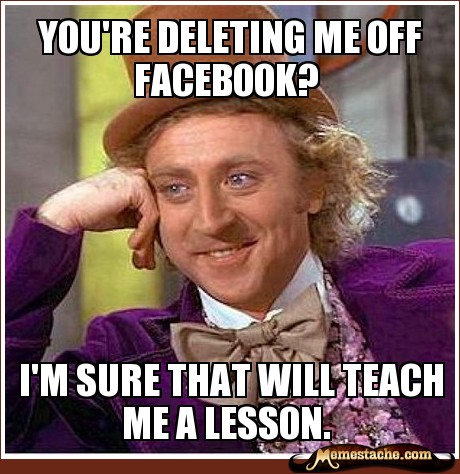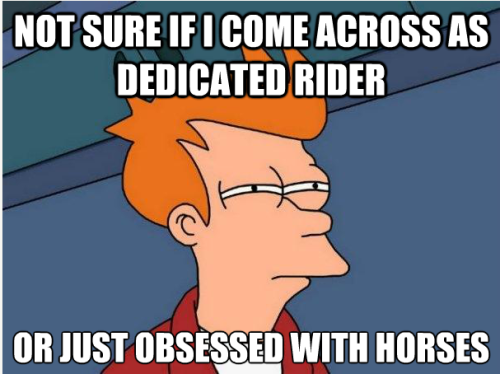Now, for a new horse owner, getting to know your new partner is paramount. But that doesn't mean showing isn't on your mind!
There are two basic types of shows - schooling and "real" shows. I've competed at both. Schooling shows include thinks like local "barn shows", some county fairs and anything called a "schooling day". Schooling shows are more informal and are great practice runs for the big thing - you still get to compete for a ribbon, but the stakes are lower (as are the prices).
Rakin' in the Ribbons at the barn's schooling show. Aside from the crooked helmet and messy hair, this is a ok show type outfit for informal schooling shows (polo is under a fleece jacket, as it's October).
Real, or, depending on your discipline, rated shows, are full dress, full on competitions. I'm an Eventer, which means I compete at Horse Trials. Horse Trials come in one, two, or three day formats, as well as 3D's which involve more events in reference to "old school" long format Eventing. There are also Combined Trials, which are more of a schooling event, but are usually full dress. Also of note is that Eventers pick COLORS, which I am a big fan of. There are many classic combinations, and some people just run in whatever they are feeling that day, but I enjoy having colors - it makes me feel part of a team, and I have a lot of pride for the Red and Green.
For schooling type shows:
I wear light colored breeches, a belt, and a polo shirt. I also wear tall boots, but half chaps and short boots that are polished up and look nice are usually acceptable as well. I also wear gloves and tie my hair back neatly. On cold days I usually layer a long sleeve shirt under a polo and try to wear a nice looking coat or sweater if it's very cold. Always wear something you can safety pin or tie a number over, or attach it to your saddle pad.
Just like before any show, you should clean your tack and generally try to match your tack and looks sharp. I usually compete in a white saddle pad, or something that works well with my polo color of choice. I also try to choose a color that looks good on my chosen horse (thus, I won't show my trainer's chestnut in a magenta saddle pad - ish!) Check with the show secretary or judge (or just err on the side of caution) as to if you are allowed leg wraps/boots or martingales in the class. And always, always, always wear a helmet.
Foxie and I at a jumper-type schooling show. I would have used a white pad for "hunters" but did both that day... and I like that pad.
For Event shows I wear three different "outfits":
Dressage: White breeches, tall boots and spurs, belt, white competition shirt (mine is a Romfh cool max show shirt) with stock tie and pin, dressage jacket (or regular coat, preferably a dark color), black gloves (until my hands are steady enough for white!) and my Charles Owen JR8 and bun cover.
For dressage, neat and tidy are the name of the game. If the arena is dusty or it's very hot, I tend to give my parents my coat and a damp rag so I can wipe down for dust and keep my coat clean right at the very end. Spurs and whips are optional, and like bits for event dressage, must be checked. This is a good thing to practice at home, and don't try something new at the show grounds.
Foxie wears her white saddle pad with black and silver accents (I'm VERY into matching), a black bridle with a snaffle bit and flash noseband (optional, but I need it for Fox) her dressage saddle and nothing else - no boots or martingales. Breast collars are allowed but only use them if you need them. While it's not written, I would braid for Eventing dressage unless your horse wears a Mohawk. Don't forget your bridle number!
Happy me, Crabby fox.
Cross Country: XC is where you get to let loose. I wear any breeches I want (usually my loud tan one with the black seat or black) with a belt, gloves, polo shirt (shirts MUST have a collar and sleeves), my medical arm band (Don't even try to warm up without it!), Eventing vest, helmet (I have a skull cap, but any will do - maybe not your nice velvet show helmet though!) and carry a crop and spurs - because going out unprepared sucks. I also wear a pinney over my armor with my number on it.
Foxie wears her jumping or XC bridle - which is usually a LOT more brakes than her snaffle, as she is very forward on XC, breast collar, saddle, event pad (green with red trim!), galloping or xc boots taped for safety, bell boots, and usually some form of our number in case we were to be separated. Never use leg wraps on XC - as you go through water and over jumps, you need something that protects, doesn't hold water or heat, won't come loose (thus the tape!) and is snug enough not to slide down or interfere. There's no stopping, dismounting, or asking for help out there.
Show Jumping:
Show jumping is the closest I get to normal jumper attire - the only difference being that I wear a stock tie, not a show shirt with collar, but that's a personal choice.
Me: Light colored breeches, tall boots, weapons of war as needed, belt, second show shirt (the first is still grubby and I fell asleep last night before washing it...), stock tie and pin, coat, helmet and gloves.
Horse: White saddle pad (I like colored trim, but you can go classic), saddle, girth, bridle, breast collar or martingale as needed and boots. Some riders go bootless, as their horses are more tired, or with open fronts to keep them careful, but Foxie doesn't usually run into any problems, so I usually just used whatever I had left after XC.
I've also been to shows where coats were waived, and I know there are shows that run SJ before XC on the same day. When that happens, look at the other competitors. I ended up showing in the shirt I wear under my jacket, as it has a collar and cap sleeves, but you'll also see polo shirts or, for those going right on to XC, entire XC "outfits" with or without the body armor.
Foxie and I on a waived coat round - 114 degree heat index!
Prepping for shows feels nit-picky but I use it as an excuse to check all my tack as I clean it (and catch any weak spots or before un-seen rips or tears, and I feel more confident going into the ring well dressed and feeling as if I've done good preparation.
A lot of times, your trainer will help you prep for your shows, and guide you on what to do. A lot of times, I prep the week before and do a light school the day before, either at home, or at the show grounds of an event. At events, that means I get to ride around (but not IN) the dressage rings, getting used to the scary flowers and swinging chain fences, get a feeling for the footing, and work to get my horse used to the showing grounds. We hack around, look at biffies, food vendors, roads, etc. At home, if I'm trailering in (or even better, showing at home) I prep for what I am doing - either a very light jump school or dressage type work.
More on fitness schedules later - and boy, do I have a LOT to say about them...
















